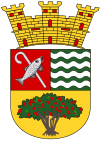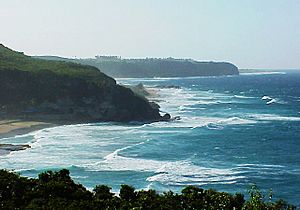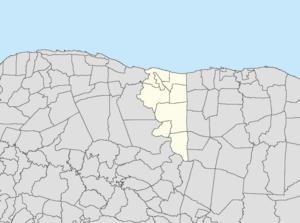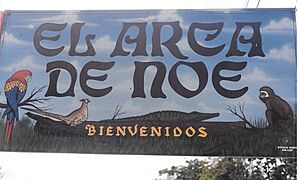Quebradillas, Puerto Rico facts for kids
Quick facts for kids
Quebradillas
Municipio de Quebradillas
|
|||
|---|---|---|---|
|
Town and Municipality
|
|||
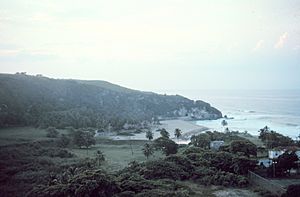
Quebradillas Beach
|
|||
|
|||
| Nicknames:
"La Guarida del Pirata", "La Ciudad del Cooperativismo"
|
|||
| Anthem: "De lejos canto, porque anhela el corazón" | |||

Map of Puerto Rico highlighting Quebradillas Municipality
|
|||
| Sovereign state | United States | ||
| Commonwealth | Puerto Rico | ||
| Settled | 1820 | ||
| Founded | June 6, 1823 | ||
| Founded by | José Ramos Velez | ||
| Barrios | |||
| Area | |||
| • Total | 27.7 sq mi (58.8 km2) | ||
| • Land | 23.2 sq mi (60 km2) | ||
| • Water | 4.5 sq mi (11.66 km2) | ||
| Population
(2020)
|
|||
| • Total | 23,638 | ||
| • Rank | 51st in Puerto Rico | ||
| • Density | 853.4/sq mi (402.0/km2) | ||
| Demonym(s) | Quebradillanos | ||
| Time zone | UTC−4 (AST) | ||
| ZIP Code |
00678
|
||
| Area code(s) | 787/939 | ||
| Major routes | |||
Quebradillas is a town and municipality located on the northern coast of Puerto Rico. It borders the Atlantic Ocean to the north. To its east is Camuy, to its west is Isabela, and to its south is San Sebastián. The town is made up of seven areas called barrios, plus the main downtown area known as Quebradillas Pueblo.
Quebradillas is often called "La Guarida del Pirata", which means "The Pirate's Hideout". This nickname comes from a famous beach in the area, Puerto Hermina. There, you can find an old structure that people believe was once a secret hiding spot for pirates and their hidden treasures.
Contents
History of Quebradillas
How Quebradillas Was Founded
The town of Quebradillas was officially founded on June 6, 1823, by Felipe Ruiz. Before this, the people living in the area faced many challenges. They didn't have their own churches, religious services, or even a place to bury the dead. They also lacked a post office and good roads.
Residents had to rely on nearby towns like Camuy, Hatillo, and Isabela. However, during rainy seasons, the Río Camuy and Río Guajataca would flood. This made it impossible to travel to other towns, sometimes for up to a week.
Because of these problems, the local residents decided to form their own town. They created a group to manage their political, economic, and administrative needs. The town's name, Quebradillas, means "small streams" in Spanish. This name was chosen because of the many small streams that flow through the area.
Quebradillas in the 1900s
After the Spanish–American War, Puerto Rico became a territory of the United States. This happened under the Treaty of Paris of 1898. In 1899, the United States government counted the population of Puerto Rico. The census showed that 7,432 people lived in Quebradillas at that time.
Hurricane Maria's Impact in 2017
On September 20, 2017, Hurricane Maria hit Puerto Rico. In Quebradillas, the Guajataca reservoir dam had a problem with its structure. To keep people safe, 800 concrete barriers were built to stabilize it. The governor ordered the Puerto Rico National Guard and police to help people living downstream evacuate. The dam holds about 11 billion gallons of water.
The hurricane caused a lot of damage in Quebradillas. Many buildings and about 2,200 homes were damaged or completely destroyed.
Geography of Quebradillas
Quebradillas is located in an area known as the Northern Karst. It is on the Atlantic Ocean coast. The town is north of San Sebastián, east of Isabela, and west of Camuy.
Guajataca State Forest
Quebradillas is home to the Guajataca State Forest, which is one of Puerto Rico's 20 forest preserves. This forest is a great example of karst country. Karst is a special type of landscape formed when limestone dissolves. You can see features like sinkholes (holes in the ground) and haystack-shaped hills called "mogotes".
Guajataca Lake and Beach
The forest also has the beautiful Guajataca Lake, which is about 2.5 miles long. This is a man-made lake where you can go fishing for different types of fish like largemouth bass and tilapia. It's also a popular spot for hiking and camping. The Boy Scouts of America have a campground there called Camp Guajataka.
The name Guajataca comes from Wahataka, a Taíno chief who once lived in this area. This chief also gave his name to Guajataca Beach to the north. Here, the Río Guajataca (river) flows from the lake and meets the Atlantic Ocean. Guajataca Beach is famous for its white sands and strong waves, making it a favorite spot for surfers. It's also a great place to relax in the sun and collect seashells.
Barrios of Quebradillas
Like all municipalities in Puerto Rico, Quebradillas is divided into smaller areas called barrios. The main town area, where the municipal buildings, central square, and a large Catholic church are located, is called "el pueblo".
The barrios in Quebradillas are:
Special Communities
Some areas in Puerto Rico are called Comunidades Especiales de Puerto Rico (Special Communities). These are communities where people might face challenges like social exclusion. In Quebradillas, some of these special communities include parts of Guajataca, Montadero, Parcelas Italas in Terranova, San Antonio, and Sector Las Piedras Barrio Cocos.
Climate in Quebradillas
The weather in Quebradillas is generally tropical, meaning it's warm all year round.
| Climate data for Quebradillas, Puerto Rico | |||||||||||||
|---|---|---|---|---|---|---|---|---|---|---|---|---|---|
| Month | Jan | Feb | Mar | Apr | May | Jun | Jul | Aug | Sep | Oct | Nov | Dec | Year |
| Mean daily maximum °F (°C) | 82.5 (28.1) |
82.8 (28.2) |
83.6 (28.7) |
84.6 (29.2) |
85.8 (29.9) |
86.8 (30.4) |
87.1 (30.6) |
87.4 (30.8) |
87.7 (30.9) |
87.5 (30.8) |
85.8 (29.9) |
84.1 (28.9) |
85.5 (29.7) |
| Mean daily minimum °F (°C) | 66.3 (19.1) |
65.4 (18.6) |
66.1 (18.9) |
67.6 (19.8) |
68.7 (20.4) |
69.9 (21.1) |
71.3 (21.8) |
71.4 (21.9) |
71.3 (21.8) |
70.1 (21.2) |
68.7 (20.4) |
67.6 (19.8) |
68.7 (20.4) |
| Average precipitation inches (mm) | 4.2 (110) |
3.0 (76) |
3.4 (86) |
4.5 (110) |
6.2 (160) |
4.8 (120) |
3.3 (84) |
4.7 (120) |
4.7 (120) |
5.0 (130) |
5.9 (150) |
5.0 (130) |
54.5 (1,380) |
| Source: Weatherbase | |||||||||||||
Population of Quebradillas
| Historical population | |||
|---|---|---|---|
| Census | Pop. | %± | |
| 1900 | 7,432 | — | |
| 1910 | 8,152 | 9.7% | |
| 1920 | 9,404 | 15.4% | |
| 1930 | 10,190 | 8.4% | |
| 1940 | 11,494 | 12.8% | |
| 1950 | 13,712 | 19.3% | |
| 1960 | 13,075 | −4.6% | |
| 1970 | 15,582 | 19.2% | |
| 1980 | 19,728 | 26.6% | |
| 1990 | 21,425 | 8.6% | |
| 2000 | 25,450 | 18.8% | |
| 2010 | 25,919 | 1.8% | |
| 2020 | 23,638 | −8.8% | |
| U.S. Decennial Census 1899 (shown as 1900) 1910–1930 1930–1950 1960–2000 2010 2020 |
|||
Tourism in Quebradillas
Places to Visit
Quebradillas has six beautiful beaches to explore. The town also used to have a private zoo called El Arca de Noé (Noah's Ark), which was open for about 50 years. It closed in 2012 when the owners were too old to care for the animals, which were then moved to the Dr. Juan A. Rivero Zoo. There was also El Museo de Muñecas (Quebradillas Doll Museum) in Cocos, which had over 1,000 Barbie dolls.
Some of the main attractions in Quebradillas include:
- El Merendero (a scenic park with ocean views)
- Miradero Guajataca (another scenic lookout)
- Guajataca Lake Reservoir
- The Liberty Theater (in the downtown area)
- Puerto Hermina Beach Pirate Ruins, which have rock carvings like La Cabeza del Indio (The Indian Face)
- Puente Blanco (an old railway bridge)
- Casa Rafols-Iribas, home to Casa de la Cultura Cacique Mabodamaca, a group that works to protect the town's culture, arts, and historical sites.
- Los Chorritos Pirata Aquatic Park (a water park)
- The municipal mini golf course
Economy of Quebradillas
Quebradillas has a small shopping center called Quebradillas Plaza. In the 1990s, the economy faced a challenge when tax exemptions for private companies ended. This led to the closure of a large textile factory, which affected many jobs in the area. Nearby towns like Isabela and Camuy also saw similar declines.
Today, the economy of Quebradillas mainly relies on retail sales. You'll find many small businesses along the two main roads that cross through the town. These include hardware stores, bakeries, pharmacies, seafood restaurants, fast food places, and car repair shops.
The town also has bank branches and local savings and credit unions. These credit unions are known for supporting local events and cultural activities, like the "Festival of the Gourd in December," sports, and educational programs.
Culture in Quebradillas
Festivals and Events
Quebradillas celebrates its patron saint festival, the Fiestas Patronales de San Rafael Arcangel, in October. This is a religious and cultural celebration with parades, games, local crafts, amusement rides, traditional food, and live entertainment.
Other fun festivals and events in Quebradillas include:
- Wake of the Three Kings – January
- Kite Festival – February
- Guajataca Carnival – January/February
- Serenade to Mothers – May
- Serenade to Fathers – June
- Quebradillas Cultural Festival – December
Sports in Quebradillas
The town's official basketball team is Los Piratas. They have won many championships in the past, including the island championship in 2013.
Other popular sports activities in Quebradillas are:
- Basketball
- Surfing – at Guajataca Beach and Puerto Hermina (Pirates Cove)
- Skateboarding – at San Jose Skatepark
- Baseball – at Los Cocos Park
- Longboarding
Transportation in Quebradillas
Quebradillas has four bridges. The town also has a tunnel that was used by steam trains in the early 1900s. These trains traveled across the island. Since there isn't much public transportation, most people use private cars to get around. The main road, Puerto Rico Highway 2, can get very busy.
Symbols of Quebradillas
The municipality of Quebradillas has its own official flag and coat of arms.
Flag of Quebradillas
The flag has two red sections. The color red represents struggle, effort, and sacrifice. The other two sections have five wavy stripes each, alternating between green and white. These stripes are similar to those seen on the coat of arms.
Coat of Arms of Quebradillas
The three wavy stripes on the coat of arms represent the quebradillas (small creeks or streams). They are set against a green background, which symbolizes the area's plant life. The fish and the walking stick are symbols of the angel Saint Raphael. These symbols come from stories in the Book of Tobias from the Old Testament.
Education in Quebradillas
Quebradillas has both public and private schools. There is also a public electronic library located near the Los Chorritos Pirata water park. In 2021, the local government opened a daycare center for children. Some schools in the town have been updated as part of a government plan to create "21st century" schools.
Schools in Quebradillas
- Manuel Ramos Hernandez
- Juan Alejo de Arizmendi
- Eugenio Maria De Hostos
- Luis Muñoz Rivera
- Honorio Hernandez
- Pedro Albizu Campos
- Ramon E. Betances
- Ramon Avila Molinari
- Ramon Saavedra
- Jose De Diego
Private schools:
- Colegio San Rafael
- Soles del Jardín
- Pequeños Aprendiendo
Images for kids
See also
 In Spanish: Quebradillas para niños
In Spanish: Quebradillas para niños



